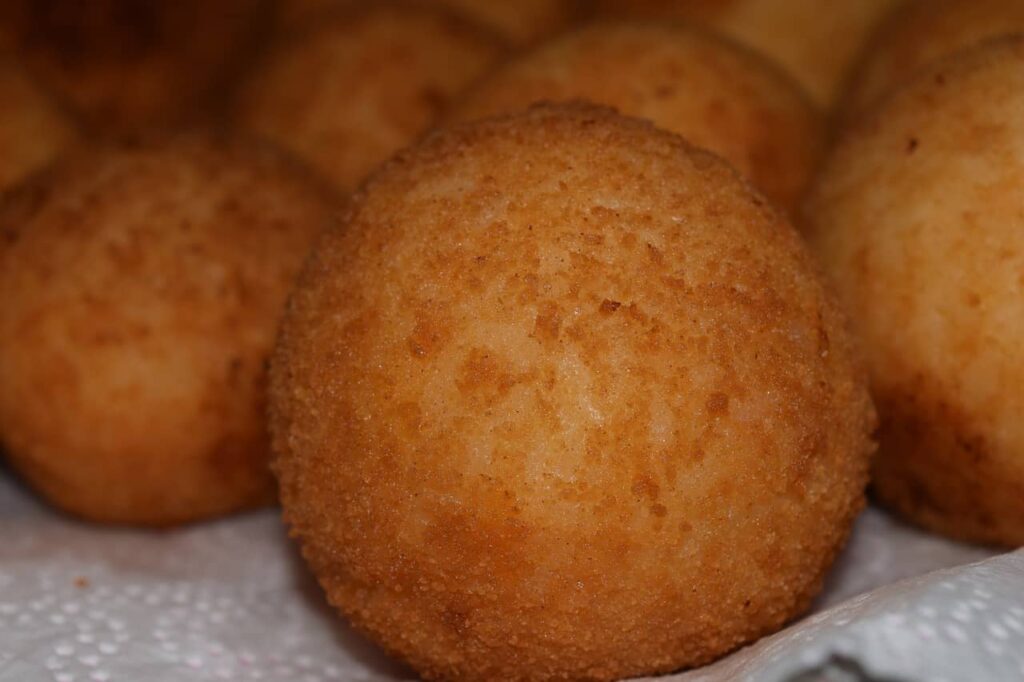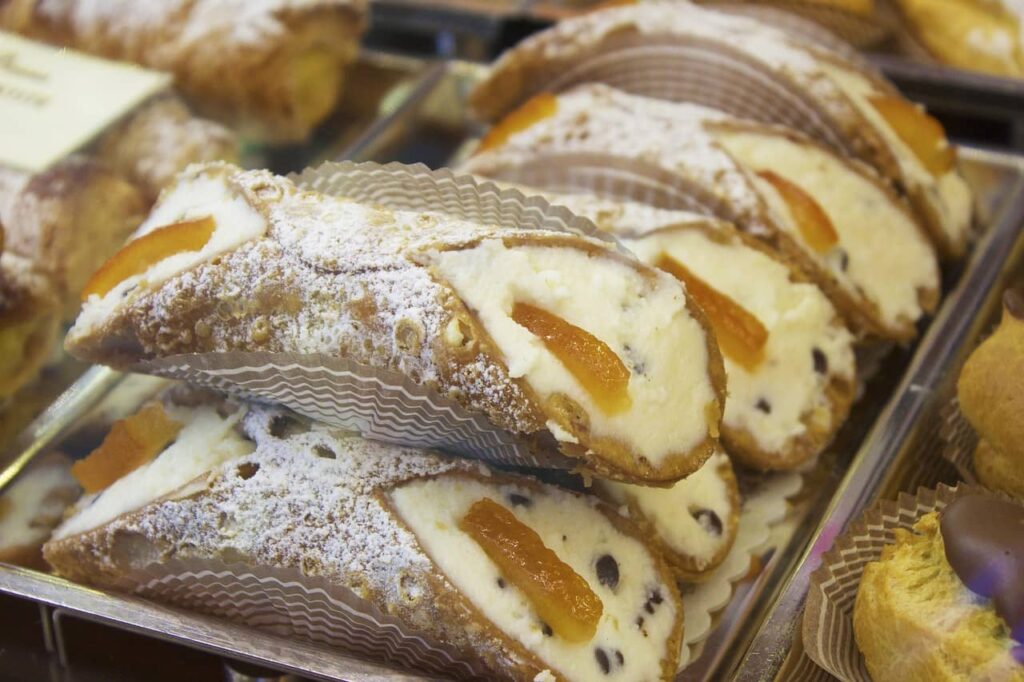To fully experience Palermo, it’s not enough to admire its beauties or stroll through its most famous neighbourhoods! You also need to taste its typical food. Palermo’s street food, in particular, is famous worldwide and is the distinctive symbol of Sicilian hospitality and cuisine. Walking through the streets of the historic centre, you will be attracted by very different smells coming from street vendors and small shops.
Arancine
“Arancine” (strictly feminine, according to Palermitani) are the queens of Palermo’s street food and are famous throughout Italy and also worldwide. For those few who may not know what an arancina is, it can be described as a ball of rice filled, breaded, and then fried. They can contain various fillings, the most traditional being with meat (ragù) and with butter (with butter, mozzarella, and ham), but there are many variations (including the most creative and daring ones): with salmon or sausage, with mushrooms or spinach, and even with chocolate. Here are some places where you can try them: Touring Café Beach – Viale Regina Elena 17, Mondello (PA); Friggitoria Arianna – Via Porta Carini 51, Palermo; Sfrigola – Corso Calatafimi 11, Palermo or Via Maqueda 223, Palermo.

Pane cà Meusa
The true symbol of Palermo’s street food: the “pane cà meusa”. We are talking about a simple and humble sandwich filled with spleen and lung of veal cooked in lard.
There are two traditional variations of this sandwich: the “schietto” (seasoned only with lemon), and the “maritato” (with the addition of flakes of aged caciocavallo cheese). “Maritato” (married) because the presence of the cheese flakes refers to the white veil of the bride. What a great imagination and poetry we Sicilians have!
The recommended places to eat them are: Pani ca Meusa Porta Carbone – Via Cala 62, Palermo; ‘Nino u’ Ballerino – Corso Finocchiaro Aprile 76, Palermo and also in Piazza Indipendenza; ‘Nni Francu u’ Vastiddaru – Via Vittorio Emanuele 102, Palermo.
Pane Panelle e Crocchè
The sandwiches with potato croquettes represent the oldest and most traditional street food of the city of Palermo. Commonly served together with “panelle” (fried squares made with chickpea flour), they are very popular and enjoyed by both Palermitani and tourists who come on vacation to visit the city.
Sfincione
It’s not quite paradise, but almost: it’s sfincione, topped with tomato sauce, stewed onions, oregano, caciocavallo cheese, anchovies and breadcrumbs; sometimes capers or olives are added too. It’s a humble dish from traditional Palermitan cuisine, born as a revision of the common bread for holidays. You can taste it around the city by buying it from “sfincionari” (street vendors) or in any bakery in the city.
Stigghiola
When it comes to what to eat in Palermo, you can’t miss trying this very strong-flavored dish, only for strong stomachs. Stigghiola is veal intestine cooked over the grill, and is actually roasted through the streets of Palermo. In this case, I don’t recommend a particular place because I haven’t found one street vendor who is better than another yet. You’ll find this dish a bit everywhere around the city, especially in the markets.
More dishes
Pasta con le sarde
Pasta with sardines is a classic of Sicilian cuisine, original for the combination of its very different and contrasting ingredients. The way they are harmonized with each other gives the whole the unmistakable flavour that has made it one of the most representative of our cuisine.
The fresh and wild aroma of fennel that envelops the strong flavour of sardines, the spicy note given by saffron, and the sweet note of “passolina” (a small and slightly tart variety of raisin) and pine nuts, are mixed in a sauce which has a unique flavour and pairs perfectly with bucatini, a pasta that gives the dish the right “relevance”. It is a Palermo tradition to prepare this exquisite dish especially for the feast of St. Joseph.
Anelletti a forno
When in Palermo people talk about “a pasta o furnu” (baked pasta), they undoubtedly refer to anelletti, the typical pasta shape of the local gastronomic tradition. Anelletti are seasoned with the equally typical Sicilian ragù, characterized by the inevitable presence of peas, and with other ingredients that often vary from area to area and even from family to family.
The variability of the ingredients mainly derives from the origin of the dish, which was born as a pantry clean-out to avoid waste.
Cannolo
A masterpiece of pastry! The Sicilian cannolo is one of the most famous products of the sweet art of our beautiful Sicily, a real guilty pleasure that is hard to resist.
The name “cannolo” seems to derive from the pastry of this dessert that in the past, before modern hygiene laws, was rolled up on small cylinders obtained by actually cutting river reeds.
It was once only made on the occasion of Carnival, but today, like all of our delicacies, this simple but fantastic dessert can be found all year round to delight our palates.

Cassata siciliana
Undisputed queen of Sicilian pastry, known all over the world as one of the best Italian desserts, cassata is a true icon of celebrations, especially in Palermo. A traditional cake that is a triumph of sugars, perfectly mixed to be in balance with each other. A sponge cake base serves as a counterpoint to layers of sweet sheep’s ricotta cheese, marzipan and candied fruit. There are different opinions on the origins of Sicilian cassata, but the most common belief is that it is a gift from Arab pastry chefs who were present in Sicily between the ninth and eleventh centuries.
